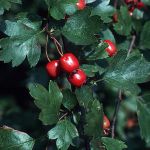| Common Name: |
Chinese Haw |
| Botanical Name: |
Crataegus pinnatifida |
| Genus: |
Crataegus |
| Family: |
Rosaceae |
| Native Location: |
N China |
| Cultivation: |
Moist soil, including alkaline, in sun or partial shade. Crataegus laevigata flowers and fruits better in open, sunny positions. Trim to shape at any time from late summer to early spring, or in winter for shrubs in which autumn color is a feature. Leaves may be attacked by caterpillars or affected by leafspot, powdery mildew, or rust. Honey fungus may cause rapid death. Crataegus laevigata, C. monogyna and their hybrids are subject to plant controls in parts of Australia. |
| Propagation: |
By seed separated from ripe berries in autumn and sown in a seedbed or cold frame. Germination may take 18 months. Cultivars do not come true from seed, and are propagated by grafting in winter or budding in midsummer on to stocks of C. monogyna. |
| Harvest: |
Flowering sprigs (with leaves) are collected in spring and dried for infusions, decoctions, tinctures, and tablets. Fruits are collected when ripe and used raw or cooked, or dried whole for use in tinctures. |
| Height: |
6m (20ft) |
| Width: |
6m (20ft) |
| Hardiness: |
Z4-7 |
| Parts Used: |
Fruits (Shan zha) |
| Properties: |
A digestive, circulatory, and uterine stimulant that also has hypotensive and anti-bacterial properties. |
| Medicinal Uses: |
Internally for "food stagnation" (a term used in Chinese medicine to cover indigestion, bloating, irritable bowel syndrome, or gall bladder weakness), hypertension associated with coronary artery disease, failure to menstruate, and postpartum pain. Fruits are used raw for circulatory disorders and baked for digestive problems. |
| Bibliography: |
Encyclopedia of Herbs by Deni BrownCopyright © 1995, 2001 Dorling Kindersley Limited. pg. 182 |

